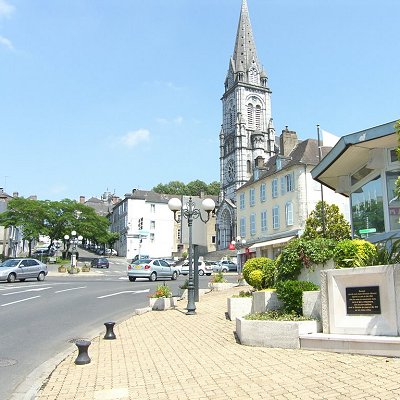
Like us on Facebook
PLACE NAMES


 
|
|
Oloron-Sainte-Marie
|

| |
Situated at the feet of the Pyrenees, 50 km from the Spanish border and 100 km from the Atlantic ocean, Oloron-Sainte-Marie is at the confluence of two gaves (mountain rivers), the Gave d'Aspe and the Gave d'Ossau that merge to form the gave d'Oloron. Capital of the Haut-Béarn, Oloron-Sainte-Marie is also at the point of origin of the three Haut-Béarn valleys : the Aspe valley, the Ossau Valley and the Barétous valley.
The town was founded by the Romans in the 1st century, then known as Illoronensium. Situated on the Roman way between the important towns of Dax and Saragossa, its position was strategic. Today known as Saint-Great, Gratus of Oloron became in 506 the first known archbishop of the Ancient Diocese of Oloron then known as "Iluro".
The history of the town during the Migration Period is little known. In 1080, the viscount Centule V, Viscount of Béarn built the new city of "Oloron" (medieval version of the Roman name Iluro) on the opposite side of the river from the diocese center. Centulle V restored the Roman walls and founded the strong city of Oloron that was to be used as a base to retake the Aragon held by the Maures. The Oloron Cathedral was built at the beginning of the 12th century. The viscountal town of Oloron and the episcopal town of Sainte-Marie were then rival, but Oloron strived on its textile industry and commerce with neighbouring Spain. Sainte-Marie became economically dependent upon Oloron.
The 18th century was the beginning of revival for Sainte-Marie as the end of French Wars of Religion allowed for restorations and new religious constructions in the town : cathedral, seminary, church Saint-Pierre. Morever, the continued boom of commerce with Spain accelerated the construction of better communication and transportation ways to Oloron and Sainte-Marie.
With the French Revolution Oloron lost its diocese to Bayonne but gained administrative importance by becoming one of the sous-préfectures of the new Republic. In the 1858, the regent Impress Eugénie imposed the reunification of the towns of Oloron and Sainte-Marie.
Oloron's architectural and historical landmarks :
- the 13th century Tour de Grède
- the former town hall and prison, classified in 1987 among as Monument historique
- the fortified walls
- the 16th century Legugnon castle
- the 17th century building in the rue Pomone, classified in 1943 as Monument historique
- the Parc Pommé
- the "Maison du Patrimoine"
- the Médiathèque public library that was awarded the Equerre d'Argent architectural award in 2010 (architect : Pascale Guédot).
- the Oloron Cathedral
- the Sainte Marie church
 Feel free to Email me any additions or corrections Feel free to Email me any additions or corrections
LINKS AVAILABLE TO YOUR SITE
| | |





